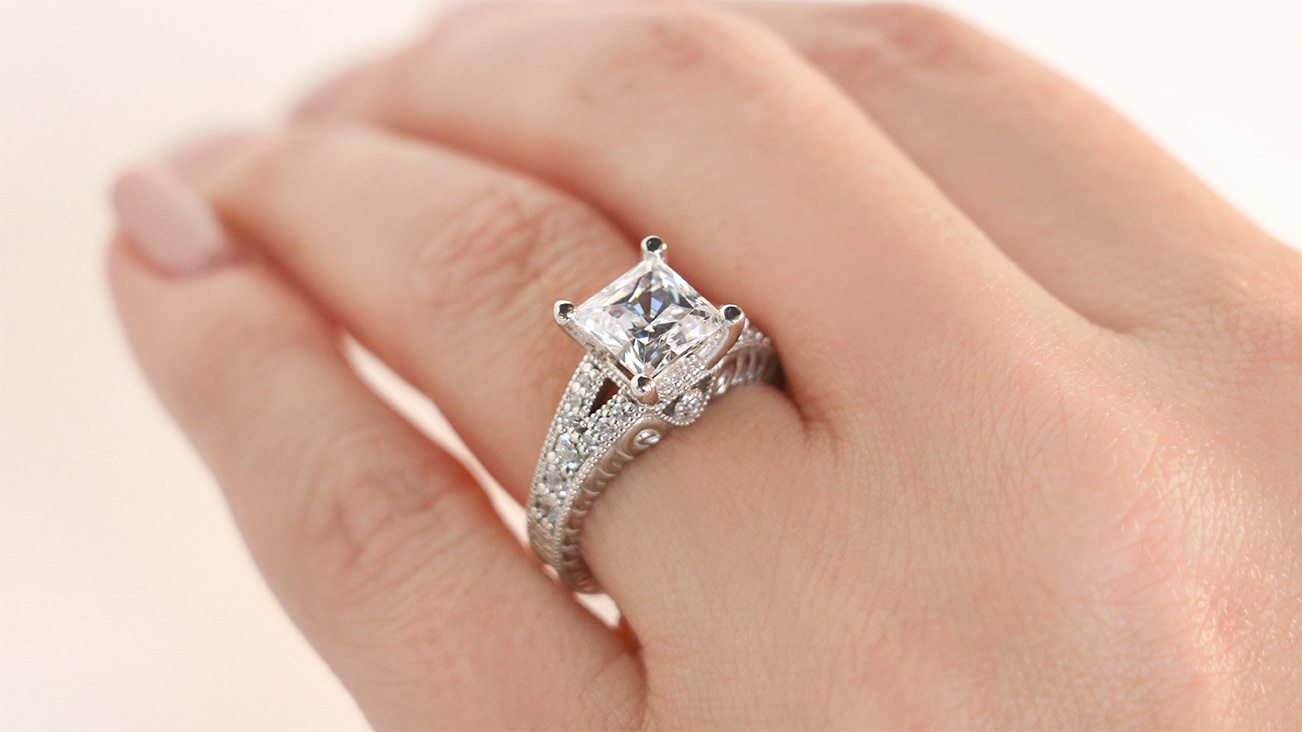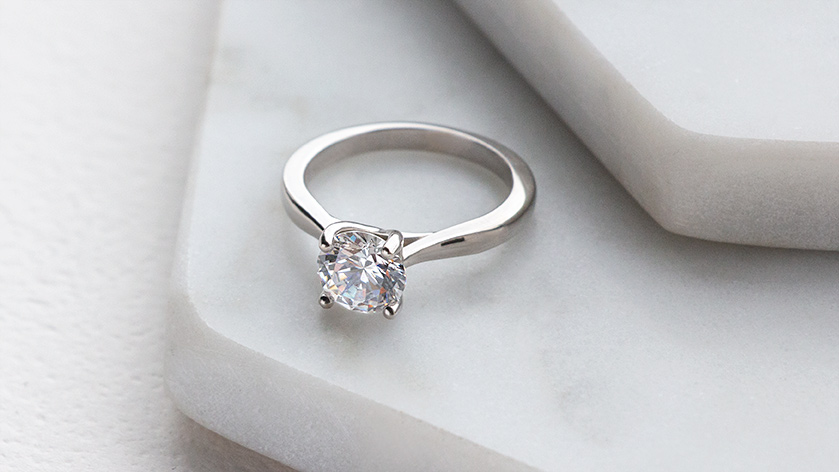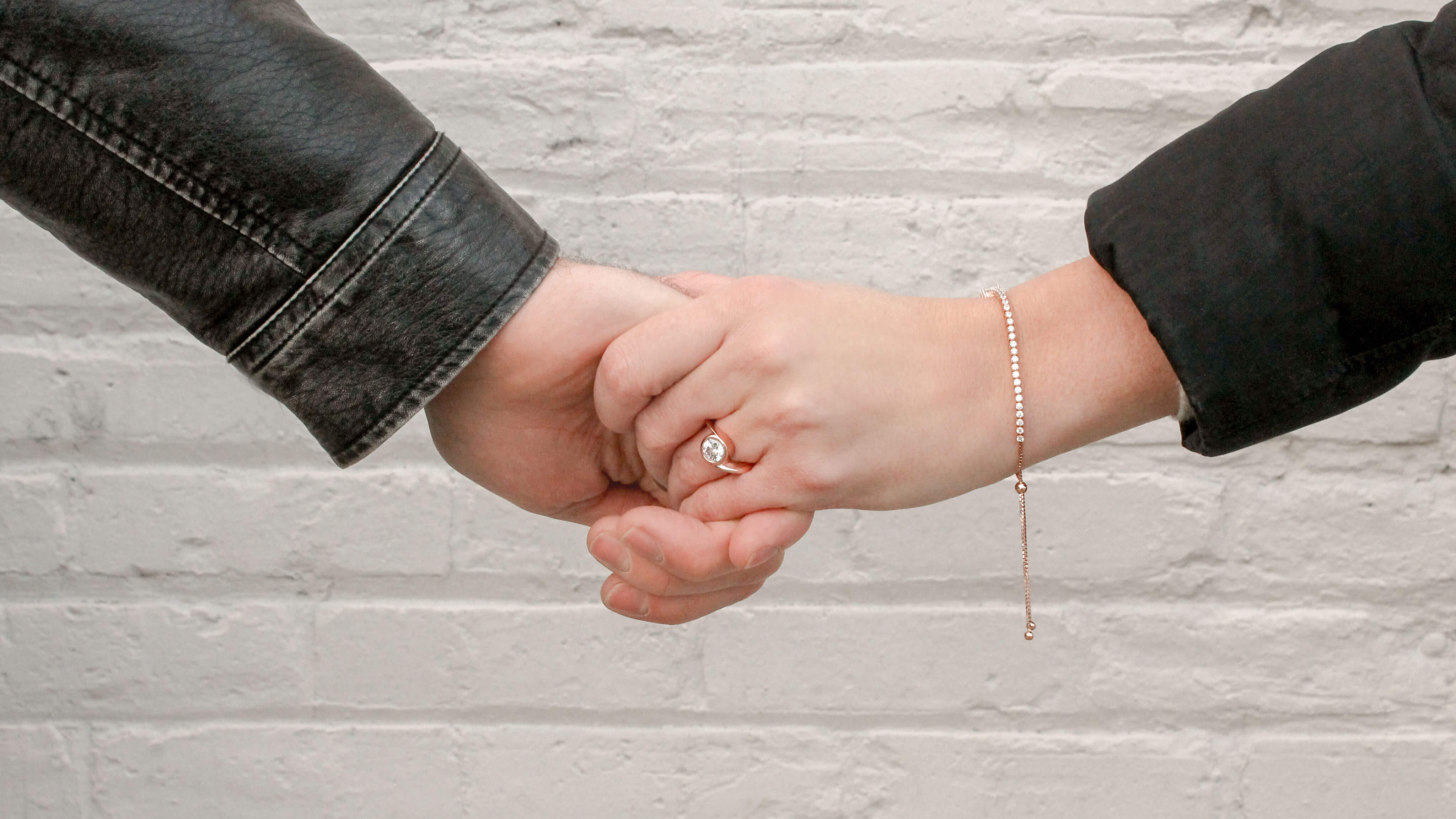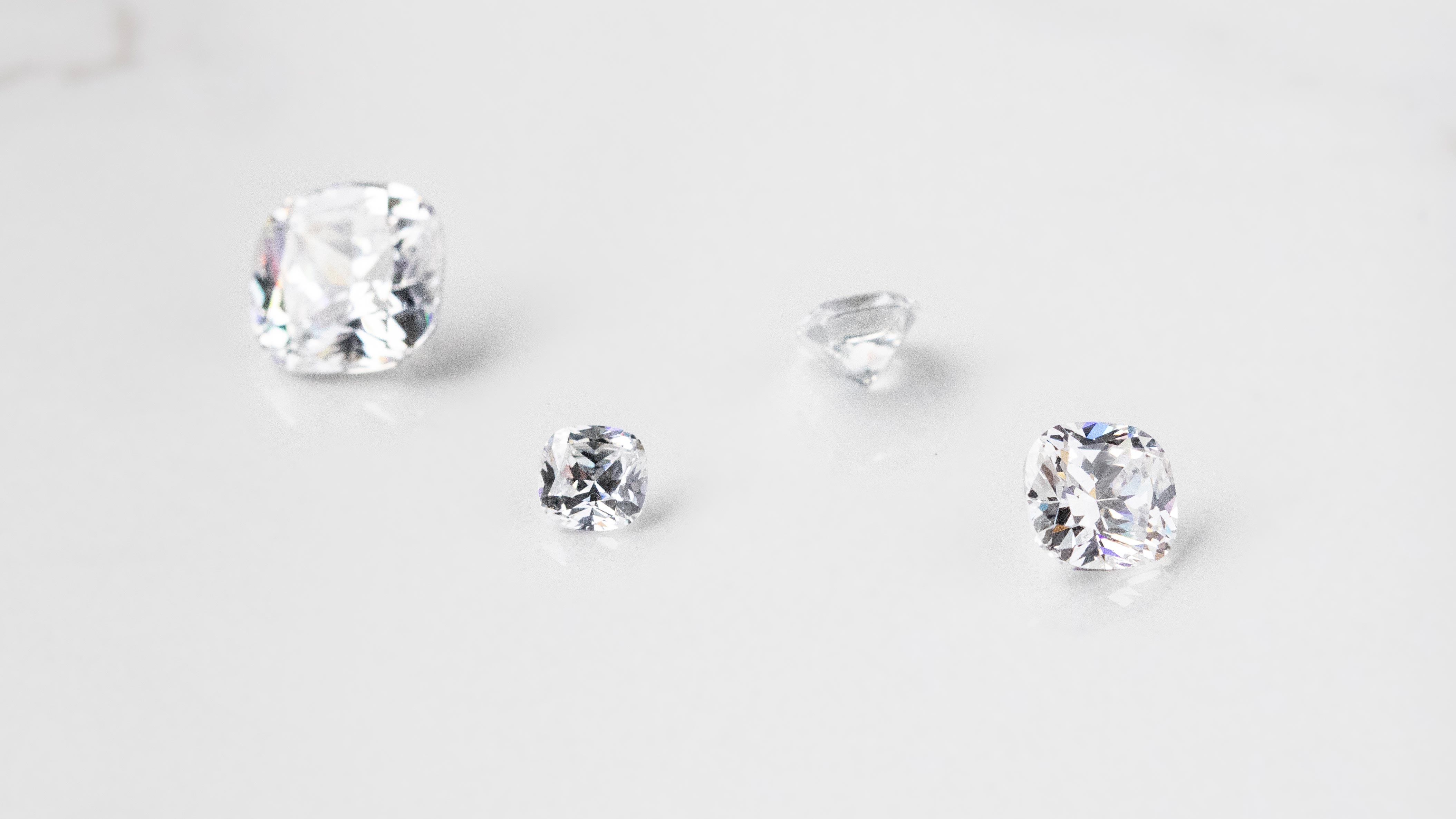How Much to Spend on an Engagement Ring
April 30th, 2019 / Alese Oldenburg
You’ve found the yin to your yang, your fearless adventure partner and the only person with whom you’re perfectly content doing absolutely nothing with. You’ve got yourself a keeper and together you’ve made the decision that you’re in it for the long haul.
When it comes to something that special, you simply can’t put a price on it.
An engagement ring, on the other hand, is a bit of a different story. Unless you’re inheriting a piece of jewelry that’s been passed down in your family for generations, it’ll likely come at a cost. But how much should you spend on an engagement ring? Well, that depends on you, your engagement ring budget and the type of ring you’d like for your partner. Before saying “I do” to just any ring, let us walk you through the process. Here you’ll learn how much to spend on your engagement ring purchase and what factors are important to consider when making your selection.

What is the Average Spend For An Engagement Ring?
The best rule when making an engagement ring purchase is to spend what you’re comfortable with. This may, of course, be affected by your partner’s particular taste in jewelry, the type of stone you’re in the market for, and whether or not you’re open to breaking a bit from tradition.
Speaking of tradition, when it comes to how many months’ salary for an engagement ring, you might have heard of the “3 Month Salary Rule.”
The “3 Month Salary Rule”
According to this rule, you should spend around three months of gross income on an engagement ring. Originally, this rule was started as a “one-month salary rule” by diamond marketers around World War II to boost sales.
Since then, the idea of a one-month salary rule eventually turned into a two-month salary rule—and, finally, into a three-month salary rule. We think it’d be best to file this practice away in the history books since it doesn’t account for net salary, inflation or the debt load you might be carrying. Rather than buy into this outdated tradition, opt for an engagement ring budget that fits your level of comfort.
Average Spend in the U.S.
If you’re curious to get into the nitty gritty of numbers, consider the following:
- The average spend on engagement ring purchases fell from 2018 to 2020.
- In 2018, the average engagement ring cost was $7,829, while the average in 2020 was only $3,756.
If these prices already seem out of your budget, don’t worry. This is just an average—an actual breakdown of the numbers shows that this average engagement ring cost is skewed based on factors such as region and economic status. The coastal regions, for example, tend to spend more on their engagement rings than areas like the mountain region or midwest.
Regardless of where you call home, we suggest making your decision based on other factors—not just the receipts of ring-buyers across the country. Let’s see what else will come into play.

Factors to Consider When Buying an Engagement Ring
Before you select the perfect engagement ring, there are a few considerations you’ll want to make before buying. Start by setting a general budget for what you’d like to spend but prepare for the total cost to fluctuate based on things like stone quality, ring style, diamond shape, insurance, and setting.
Here’s a breakdown of how some of those factors might have an effect on your wallet.
#1 Your Budget
A good engagement ring doesn’t always mean the best, brightest and biggest. So don’t be afraid that you’re underspending if it’s something both your partner—and bank account—will love.
With your budget, there are a host of factors to consider. Here are some things you should keep in mind when totaling the engagement ring price:
- Insurance – Before settling on a ring you think your partner will love, remember that there might be more to the price tag than meets the eye. Insurance can be an important—and sometimes costly—addition. However, spending the extra cash could be well worth what you’ll gain when it comes to peace of mind. While the exact cost of insurance will depend on a variety of factors, you’ll want to leave some room in your budget to account for this kind of protection in case the ring gets lost, stolen, or damaged.
- Type of ring – Are you willing to sacrifice on any of the 4Cs (cut, carat, color and clarity)? What about the setting, stone or the band? The size or number of stones can have a significant change on your budget. We’ll get more into the specifics later, but be sure to keep this in mind as you start to crunch the numbers.
- Your future financial goals – A new engagement can often come with a number of other new expenses—and sizable ones at that. So if you’re planning on splurging on an extravagant wedding or saving to buy a new house for you and your partner, this will be something to consider when allocating funds for a ring.

#2 Your Partner’s Preference
The beauty of an engagement ring is about what it symbolizes: your love for your partner and your commitment to them no matter what life throws at you. While that sentiment is what’ll get you through the ups and downs of married life, the last thing you want to do is buy a ring that your partner dreads wearing.
Before you make the purchase, consider your partner’s preferences, including their engagement ring style and what type of ring fits their personality. Try some of these options to help make sure your fiance-to-be is just as in love with the ring as they are with you:
- If you’re not afraid of spoiling the surprise, ask them outright what kind of ring they might want.
- Go “window shopping” to figure out their preferences.
- Ask friends and family for advice.
- Consider their fashion sense, hobbies and lifestyle.
Keep all of your partner’s must-haves in mind and stay tuned as we break down your options for a budget-conscious choice in just a bit.
#3 The Type of Ring
When you ask the big question, what kind of sparkle will accompany your proposal? Something traditional and timeless, or modern and show-stopping? As you begin ring shopping, you’ll notice that there are a variety of ring types, stones and qualities to choose from. To help you plot out some of the types of rings you can consider here’s a list of factors that may have an impact your ring’s look and cost:
- Diamonds vs. gemstones – If you’re not married to the idea of a diamond, you can always consider gemstone alternatives. Plus, gemstones are often suitable for a wide variety of budgets. For something a bit more cost-effective, you can consider something like moonstones or opals. If you can allow yourself some flexibility with spending, consider some premium gemstones like sapphires, rubies and emeralds.
- Quality of the diamond – Here’s where the 4Cs come in: cut, clarity, carat and color. If size is your top priority, then you’ll want to focus on the diamond’s weight in carats. Maybe you’re in search of something rare and blemish-free. If so, you can expect costs to go up in the clarity department. Be clear about what characteristics are the most important to you and chat with your jeweler to learn more about how your must-haves will come into play when it comes to price.
- The metal of the ring – Just as important as the stone is the band on which it rests. For something elegant and ultra durable, platinum is your best bet. However, it’s also the most expensive. Try not to sacrifice your investment by opting for a metal that won’t last. Instead, consider looking into alternatives like white gold, yellow gold or rose gold.
- The setting – The setting determines the overall look and feel of your engagement ring and can greatly impact the cost. Pavé setting styles, for example, tend to be more expensive than others. A well-selected setting can enhance just about any ring, so be sure to take this into account when considering what you value more in your ring—the stone or the setting.
#4 Affordable Alternatives
Another way to spend smarter before your proposal is to search for an affordable alternative to the traditional diamond ring. As we’ve already mentioned, you could swap out for something eye-catching and unique like:
- Opal
- Moonstone
- Emerald
- Sapphire
- Ruby
Instead of opting for a different stone altogether, you could save a few pennies by purchasing a:
- Colored diamond – Personalize the piece by choosing a diamond based on your partner’s favorite color. Plus, breaking away from the traditional white diamond could end up cutting costs by 75 percent.
- Lab diamond – Switching to an alternative lab-created diamond could shave up to 80 percent off the price of a mined diamond. They’re ethically sourced, made of carbon and just as stunning as their mined alternative.

How to Save on Your Engagement Ring Spend
You’re nearly an expert on all things engagement rings, but we couldn’t send you off on a ring shopping trip without equipping you with a few more tools. Once you’re ready to spend and make the ultimate commitment, here are some useful tips to help you maximize your budget:
- Shop online – According to experts, you can save up to 30% to 50% off when you shop online versus a brick-and-mortar jewelry store. Another online shopping perk? You have a wider selection and the ability to customize the ring as you see fit for your partner.
- Give up some carat size – You don’t even need to give up a significant portion of the carat size to have an impact on the final bill. While a 0.97-carat diamond might look nearly identical to a 1.0-carat diamond, the cost of the actual stone can significantly decrease.
- Try a multi-stone ring – Consider purchasing a ring with multiple stones that surround a center stone alternative. This not only gives the illusion of a larger carat size but helps bring down the budget when compared to a solitaire ring.
- Explore an antique or heirloom ring – Rings that are heirlooms or antiques often have their own history to tell. These rings can be just as romantic as a new ring, and offer an option for those under a strict budget. If you think your partner would enjoy the charm of a family heirloom, then you might want to consider this option.

Regardless of the ring you choose, remember that what’s most important is how special it means to you and your partner. With the right budget and the right ring in mind, you can make your engagement a truly fun and memorable experience.

Find Your Dream Ring at Diamond Nexus
If you’re set on diamonds and sticking to your budget, consider making your purchase with Nexus Diamond™. Our collection of diamond alternatives simulate the look and feel of a mined diamond. Plus, the ones at Nexus Diamond could cost you up to 80% less.
Save money on this once-in-a-lifetime purchase without sacrificing the beauty of your stone. Pop the question with a Nexus Diamond. Saying “yes” has never been easier.
Sources:
- theknot. Here’s How Much to Spend on an Engagement Ring.
https://www.theknot.com/content/how-much-to-spend-on-engagement-ring#average-engagement-ring-cost - Brides. How Much to Spend on an Engagement Ring: Your Official Budget Guide.
https://www.brides.com/story/proper-cost-of-engagement-ring - Harper’s Bazaar. How Much to Spend—and Where to Save—When Shopping for an Engagement Ring.
https://www.harpersbazaar.com/wedding/planning/a28015838/how-much-to-spend-on-engagement-ring/ - Nerd Wallet. Cheap Engagement Rings: At Least 5 Alternatives to Diamonds.
https://www.nerdwallet.com/blog/finance/engagement-ring-alternatives/
*Diamond Nexus strives to provide valuable information, while being clear and honest about products. The Nexus Diamond™ alternative is a patented lab grown stone that, among all simulants, most closely imitates the look, weight and wear of a mined diamond, with two exceptions – it is absolutely perfect in every way, and it costs significantly less. Price points expressed in this blog were taken from popular online retailers and may vary. Learn more about the environmental impact of mining on our blog.

